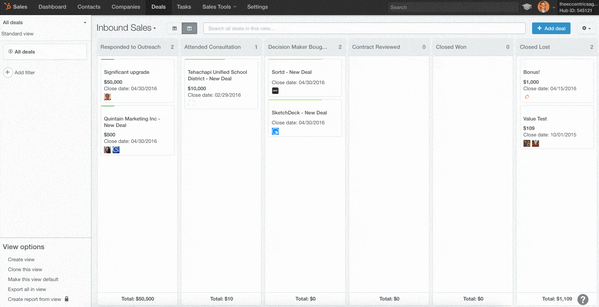Converting Your Sales Process Into Deal Stages With HubSpot
Customer relationship management (CRM) is a technology for managing all your company's relationships and interactions with customers and potential customers. The goal is simple: Improve business relationships to grow your business. As it turns out, sixty percent (yes, 60%) of HubSpot CRM users haven't used a CRM to improve in their Sales Training before.
If you’ve struggled with using deals yourself, this post is for you!
What is a deal?
Deals are used to track your sales. They are organised into columns that represent the different stages of your sales process. You can easily drag and drop individual deals as your sales progress.

The CRM comes with some default deal stages already set up. You're certainly encouraged to customise the deal stages to represent your own sales process. If you don't know how to express your sales process as a series of columns, don't worry — the remainder of this post is all about figuring that out.
Access Your Deals in HubSpot
Re-Examining your Sales Process and porting your Deal Stages into HubSpot
Your deal stages should give a clear indication of how close a deal is to closing. When it comes time to forecast your monthly revenue, you want your deal stages to take away as much of the guesswork as possible. In order for this to work, every deal stage needs to have these three characteristics:
- Factual - A step is factual if it’s based on actual actions that have been taken rather than a feeling or intuition you or the buyer might have.
- Inspectable - A step is inspectable if there’s some sort of record that can be used to prove that the action has been taken.
- Buyer-centric - Ultimately, it's the buyer's actions that will close the sale. The sales rep is just there to help. So as much as possible, base your deal stages on actions the buyer takes.

Let's use these three characteristics to re-examine each step of our sample sales process.
The first step is a meeting between the buyer and the seller to demo the product.
This is factual because a meeting requires real action from both the seller and the buyer. It’s also inspectable because there is likely some sort of evidence that it occurred, such as a calendar event, a web meeting recording, a phone call, or a follow-up email. To make this step buyer-centric, we'll call it "Evaluate Product" because that's what the buyer is doing.
The second meeting is factual and inspectable for the same reasons as the first meeting. We'll call this step "Decision Maker Evaluates" to make it buyer-centric.
The next step is for the decision maker to approve the purchase.
This may or may not be factual because the decision maker might not have to do anything more than shrug their shoulders and say, "Fine by me." It also isn't inspectable because, in many cases, you won’t know for sure if this has happened until the contract is returned. It isn't factual or inspectable, so we’ll remove it from this list.
The next step is sending the contracts, which is factual and inspectable, but it's a seller action rather than a buyer action. When you have a factual, inspectable step that is seller-centric, ask yourself what this looks like to the buyer.
In this case, the buyer is receiving the contract, so "Contract Received" would be a buyer-centric rendering of this step. This is still factual because it requires the seller to send the contact, and it's inspectable if the contract was sent in a tracked email.
The final step is signing and returning the contract.
This is factual and inspectable, and it's a buyer action, so it's perfect as is.
The last thing you need to do is make sure none of the steps coming over from your Sales Process are redundant. In general, when it comes to creating deal stages, the old adage of "less is more" definitely applies. The more stages you have, the more complicated and confusing your process will become.
One very simple way to remove extra deal stages is to keep an eye out for redundancy, so let's look through this sales process one more time and take out any duplicate stages.
Again, in this example we’re assuming that two meetings are necessary for the sales process, so we’ll leave both of those in place.
There's also receive contract.
We have to ask ourselves if this is significantly different from the "Sign/Return Contract" in your initial Sales Process. If you think about it for a moment, receiving a contract doesn’t necessarily move the sales process forward. If the buyer receives the contract but never signs and returns it, the sale hasn't actually progressed at all.
Even though receiving the contract meets all three of our characteristics, it doesn’t matter much until the contract has been signed and returned. Since signing and returning the contract is the more significant action, we'll cross off "Receive Contract" from our initial Sales Process chart and keep "Sign/Return Contract."

The three key steps in your deal stages
All three of these steps are required for every sale, they are factual and inspectable, they are buyer-centric, and they aren’t redundant. This is a good sales process.
Now let’s translate it into deal stages. The actions in your sales process are what signal that a deal has moved from one stage to the next, so the names of your deal stages will be past-tense version of these actions.
Once you've translated your sales process into deal stages like this, there are two additional stages you'll want to add: an "On Radar" stage and a "Closed Lost" stage. You can call these stages whatever you want, but here's what they mean:
- On Radar - This is where you'll put deals when you first create them. This stage will come before the first stage and is for prospects who have raised their hand but haven't taken action yet. A common name for this stage is "Appointment Scheduled," but you'll want to name it whatever best represents the way your prospects first show interest in your solutions.
- Closed Lost - Not every deal goes the distance, so it's good to have a stage where you can put the ones that don't make it. When a prospect tells you they aren't interested in moving forward, move their deal to this stage to keep it from throwing off your forecast.
With the addition of these two, we have five deal stages: On Radar, Product Evaluated, Evaluated by Decision Maker, Contract Signed and Returned, and Closed Lost. This is a solid deal pipeline.




